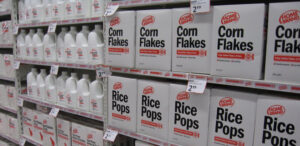
After experiencing unprecedented double-digit growth in 2020 fueled by pandemic shopping behaviors, private label brands grew by a more modest 1% for the full-year 2021, but gathered steam again during the first quarter of 2022 registering 6.5% sales growth compared to the same period last year, according to the Private Label Manufacturers Association (PLMA).
While similar information from the foodservice industry is not as freely available, our own research in this area has shown a marked increase toward distributor labels during the past six months. Inflation, shortages, private label category expansion and a more savvy DSR have contributed to the shift away from national brands.
What Foodservice Can Learn From Retail Consumers
If we use retail consumers as our guide, many grabbed whatever products and brands they could get their hands on during the height of the pandemic. In this process, consumers were introduced to private label options across categories, which they re-purchased even as their favorite brands became available at store, according to a McKinsey & Company report.
That report also found that more than 90% of US consumers indicated in January 2021 that they will buy the same or more private brands after the pandemic.
How Manufacturers Can Mitigate Brand Erosion
A big difference between foodservice and retail, however, is that operators purchase supplies, not the diners. While operators strive to supply what diners want, each category has different exposure to a patron. For example, a back-of-house bulk sauce will get very little (if any) visibility to a consumer, while a condiment or dressing on the table will have tremendous patron interaction.
We have compiled a list of attributes important to operators and compared distributor label versus manufacturer label as a quick exercise:
| Important Attribute – Operator | Natl. Brand | Dist Brand | Comments | Manufacturer Responses |
| Value | Low | High | · There is much more parity in the buyer’s minds between national and private label today. Exclusive brands use the 4Ps the same way a national brand might. | · Demonstrate higher patron satisfaction with national brands.
· Side-by-side cuttings. · Use evidence-based research to support findings. · Make sure formulations are different if you are a co-packer and a national label for the same category. |
| Quality | High | High | · Concerning, because the lines have blurred between “Arrizio” and “Barilla” to some extent. | · Increase operator pull-through.
· Cut down on misinformation from DSRs claiming “X national is packing our brand and it’s 50% less.” |
| Availability | Moder-ate | High | · This is an FSIP estimate based on June 2022 conditions that allow distributors to use their own stock and build it quicker than national manufacturers can supply. | · This is a real issue for many manufacturers, especially for those that even customers ask for but can’t attain because of supply shortages. Stay close to distribution houses when supply once again picks up so as not to permanently lose position. |
| Promotional Support | High | Low | · This may be a “Catch 22” in that higher promotions may erode profits and hurt a brand in the long run. A DSR will most likely push its own brand first. | · Avoid price-cutting promotions and focus on those with loyalty-building and volume growth to achieve a sustainable advantage. Price is not a sustainable advantage. |
| Operator Education | Moder-ate | High | · DSRs are much more likely to give operators information regarding their own brands, especially if they are tasked with 5,000 skus per sales call. | · Staying close to DSRs, running incentive programs along with a combination of operator pull-through will help mitigate further erosion. |
Looking Ahead
The threat of distributor label is not new. Whenever the U.S. Economy faces higher prices, the natural response is for buyers to seek out less expensive options. Our recommendation for this cycle is to promote quality, customer service and to share evidence-based research with operators to “prove” your product is far and away more coveted by diners than an “off” brand.
Tim Powell is a Managing Principal of Foodservice IP. Tim serves as a trusted foodservice adviser to management at several food companies.
Like the content? Sign up to receive our communications.
Recent Comments